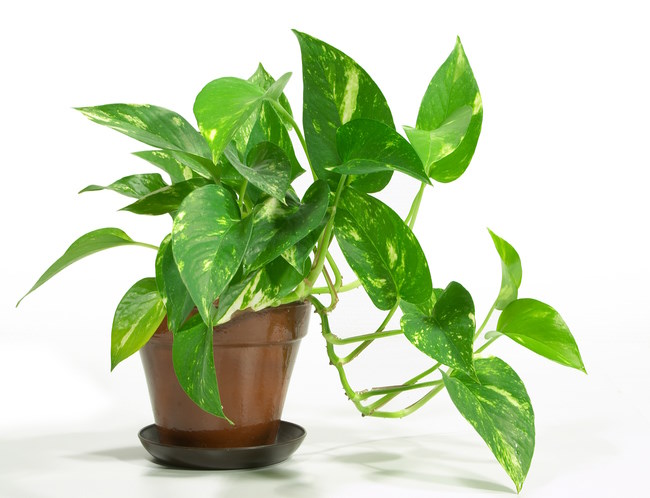Golden Pothos (Epipremnum
aureum)
Last
updated: August 3,
2025
Care Sheet List
The Golden
Pothos is one of the most popular and easiest houseplants to grow,
known for
its heart-shaped green leaves splashed with vibrant yellow or gold
variegation.
It's a versatile vining plant that can be grown in hanging baskets,
allowed to
trail, or trained to climb.
Lighting
Golden
Pothos is incredibly adaptable to various light conditions, making it
an
excellent choice for beginners.
- Ideal: Medium
to bright indirect light encourages the most vibrant
variegation. A few feet away from a bright window (east, west, or even
south with sheer curtains) is perfect.
- Tolerates: It can survive
in low light conditions, but the golden variegation
will become less prominent, and the leaves may appear mostly green.
- Avoid: Direct,
harsh sunlight can scorch the leaves, causing brown spots.
Watering
Routine
Pothos
prefers the soil to dry out between waterings.
Overwatering is a common
problem that can lead to root rot.
- Frequency: Water when the top
2-3 inches of soil feel dry to the touch. You can also
observe the leaves; if they start to look slightly droopy or limp, it's
a good sign it's thirsty.
- Method: Water
thoroughly until you see water draining from the bottom of the pot.
Discard any excess water that collects in the saucer.
- Seasonality: Reduce watering
frequency in fall and winter when the plant's growth naturally slows
down.
Fertilizer
Requirements
Golden
Pothos is not a heavy feeder.
- Schedule: Fertilize
during its active growing season, typically from spring
through early fall. Once every 2-4 weeks is sufficient.
- Type: Use a balanced
liquid houseplant fertilizer.
- Commercial Recommendation: Miracle-Gro
Indoor Plant Food (Liquid) or Schultz Liquid Plant
Food are easily available options. Dilute these commercial concentrates to achieve approximately 50-100 ppm N
in your final solution. This is often equivalent to using them at "half
strength" or "full strength" of the package's recommended dose.
- DIY Fertilizer Suggestion: For healthy foliage, use your homemade 3-1-2 liquid fertilizer concentrate (High Nitrogen) or a balanced 1-1-1 liquid fertilizer concentrate.
- For 3-1-2 concentrate (30,000 ppm N): Apply at a "Light Feeding" rate, using 1.67 ml per 1 liter of water (resulting in ~50 ppm N). See recipe details.
- For 1-1-1 concentrate (10,000 ppm N): Apply at a "Moderate Feeding" rate, using 10 ml per 1 liter of water (resulting in ~100 ppm N). See recipe details.
- Avoid: Do not
fertilize in late fall and winter when the plant is dormant.
Misting
Requirements
Golden
Pothos tolerates average household humidity well and generally does
not
require regular misting. However, it can appreciate slightly
higher
humidity, especially if your home air is very dry (e.g., during winter
with
heating on).
- Optional: Occasional
misting a few times a week or placing the pot on a pebble tray filled
with water can be beneficial, but it's not crucial for its survival.
Pot Size
and Soil Type
- Pot Size: When repotting,
choose a pot that is 1-2 inches larger in diameter
than its current one. Pothos can thrive even when slightly root-bound.
Repotting is typically needed every 1-2 years or when roots are
circling the pot or emerging from drainage holes. Ensure the pot has drainage
holes to prevent waterlogging.
- Soil Type: Use a well-draining,
all-purpose potting mix. A standard houseplant potting mix is
usually suitable. You can enhance drainage and aeration by mixing in
some perlite (about 1 part perlite to 4-5 parts
potting mix), which can be particularly helpful if you tend to
overwater.
Pruning
and Maintenance
- Pruning: Pothos can
become very long and leggy over time. Prune back long vines to
encourage bushier growth. You can cut just above a leaf node (the point
where a leaf emerges from the stem).
- Propagation: Pothos is
incredibly easy to propagate from stem cuttings. Simply take a cutting
with 2-3 leaves and a node, and place it in water or moist soil. Roots
will often form within a few weeks.
- Toxicity: Keep out of
reach of pets and small children, as Pothos is considered toxic if
ingested due to calcium oxalate crystals.

